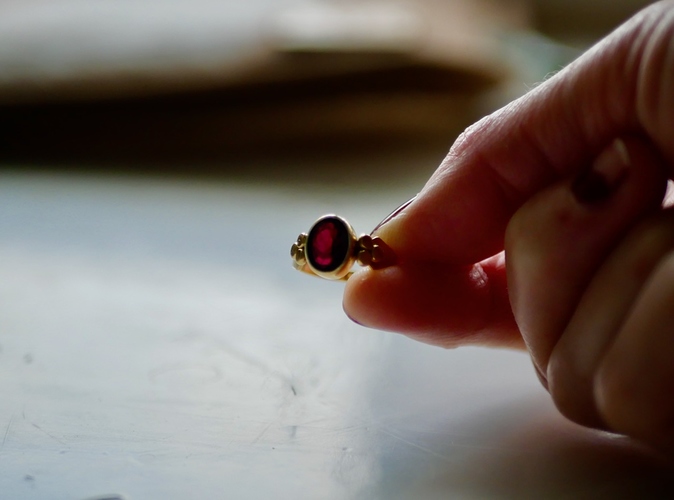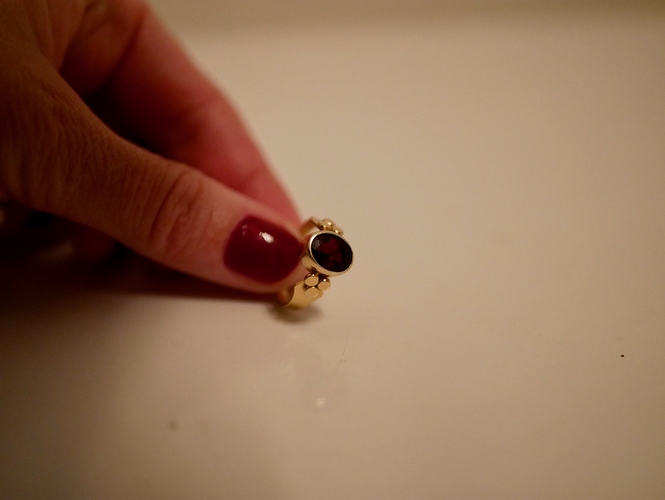In have a question regarding the stone I have purchased through a fellow jeweller. I have ordered a rubellite, and I’m quite sure it IS a rubellite, but just recently other jewellry maker raised some doubts. She said, it might be a garnet, which means a drop in price… The stone in naturall light is dark red/purple, with visible violet hues in the artificial ligh. What do you think guys?
Hi Gosia.
It is hard to say just by looking at the pics but it seems that you should be able to check it with a refractometer without interfering of the ring. You could also try with a dichroscope to check the pleochroism.
Regards
Pierre
As Almandine Garnet and Rubellite Tourmaline have different densities and refractive indexes, either of these tests should give you a definitive answer.
Also, did the buyer provide a certificate of authenticity for the stone? I would think this documentation should be obtainable.
Hope this helps.
Hi Gosia, the question is rubellite or garnet?
Can you get light through the mounted stone?
If the back of the mount is open, a polariscope will give you the answer. Garnet is single refractive a rubellite is double refractive. Hope that helps. Also as previously suggested take a RI reading: Rubellite 1.64 Garnet 1.69 to 1,89.
Good luck!
If you’re concerned only to establish either garnet or rubellite, a dichroscope will show two colors of red or pink for rubellite and only one color for garnet. But, if you’re not sure between garnet and rubellite, couldn’t it be anything? In that case, you might need more testing. The dichroscope plus the RI on a refractometer would pretty much cinch it between garnet and tourmaline…but if it ends up being 1.76, it could be corundum, too, couldn’t it…rather than garnet? And if corundum, it isn’t likely they sold you a natural ruby or pink sapphire at a tourmaline price, so you’d have to consider whether it was a synthetic. Which means a good look thru a loupe, and if no bubbles, maybe a microscope to look for curved striae or other telltale inclusions. Is the seller reputable? Why not discuss it with them? This kind of question is why you shouldn’t buy from anyone who won’t take a return, and if you do buy from an unfamiliar source, you should have a gemologist ID or appraisal or good gemological skills.
If you have a Nd magnet… it is extremely easy to tell if it is garnet. Put the magnet close to the gem (the setting will have no effect) and if it is a garnet it will be so strongly attracted to the magnet that the ring can be dragged across a smooth table top.
Dion,
Of course, you’re quite right, but you do need a strong magnet…just read the gem magnetism website. I have some extra N58 standard magnets I need to get rid of, if anyone wants one for cheap.
You can purchase a 1/2" x 1/2" N-52 cylindrical magnet for a few dollars at a hobby store (used in model train hobby), and put it on a 1/2" x 3" bolt head… to make an excellent “magnetic probe”… the magnetic susceptibility index for rubellite is only 78, whereas garnet’s SI value is 15x greater around 1500 SI. I use my magnetic probe to distinguish many common look-a-like minerals. You can download from the web the “Magnetic Susceptibility Index for Gemstones” , giving you the responses to this standard magnetic probe for some 250 different minerals. Hope this longer explanation is helpful in distinguishing the “red” stone you have.
Correction, I have N52 magnets. I was not aware that they are commonly available in hobby stores…ordered 20 of them on line for a presentation. Yes, agree the article and the whole gem magnetism site is a great addition to easy, cheap gemology. Unfortunately in this thread, if you’re talking about is it synthetic or natural, the only really useful tool is the microscope and a brain that knows the inclusions. Occasionally UV shows differences between synthetic and natural but they are inconsistent. If your only concern is is it rubellite or garnet, the magnet, the dichroscope or the polariscope will do it for you.
Thank you guys for sharing your knowledge, and suggestions! I will try refractometer / dichroscope, but I will start from the magnet. I want to check, if it works!
spectroscope will show ,as most red garnets has a easy spectrum to identify it from other stones , once learnt never forgotten . good luck.

